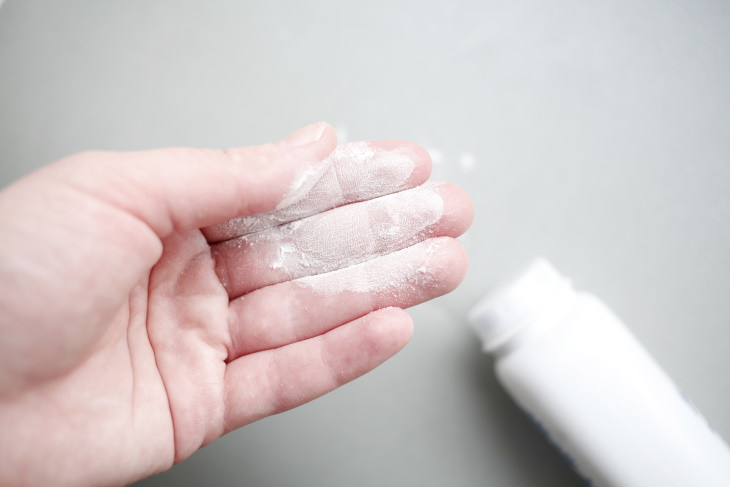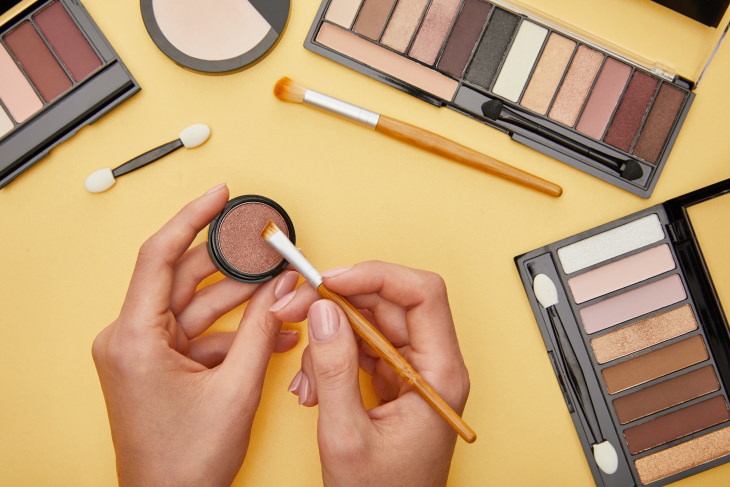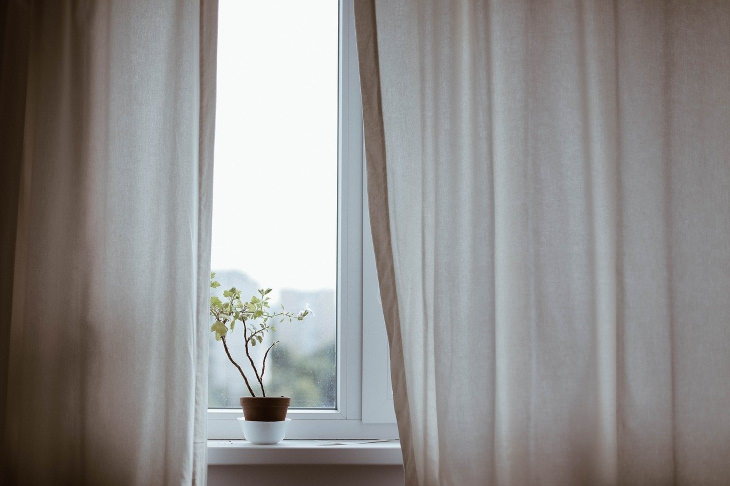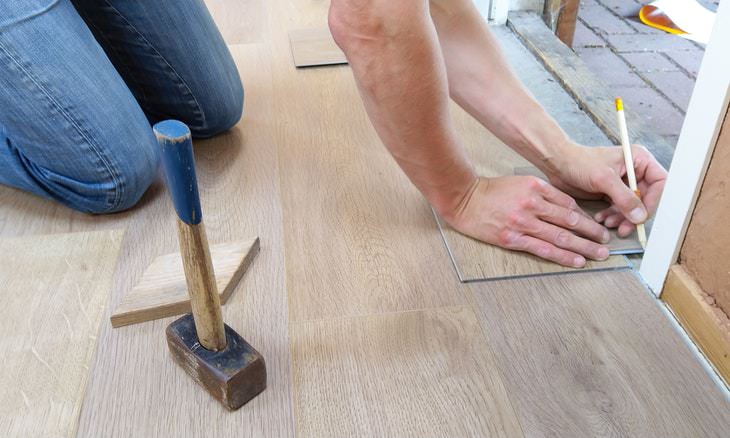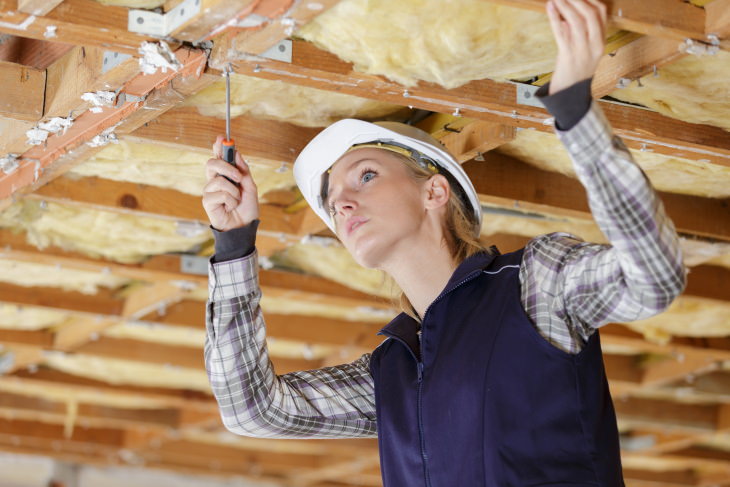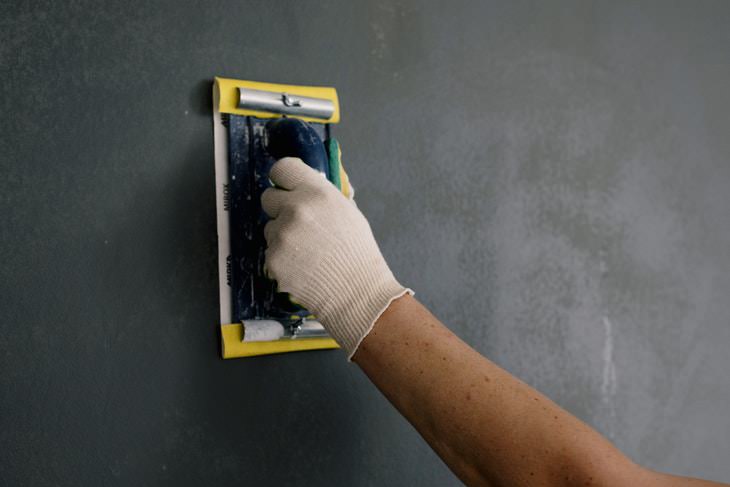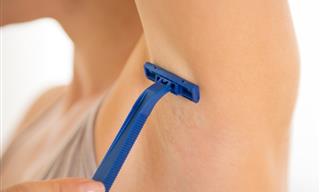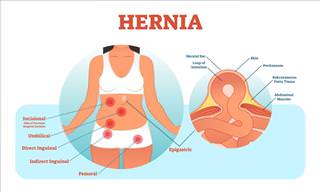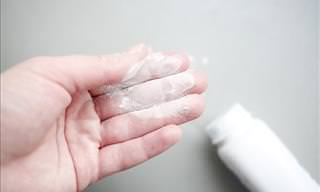1. Baby Powder
Asbestos is dangerous to humans when it’s inhaled, so it’s especially concerning that so many baby powders contain the toxic chemical, putting both babies and parents at risk. But how does asbestos get into baby powder, to begin with? First of all, let us reassure you that not all baby powders contain this dangerous substance, only some of the talc-based powders do. Talcum powder is a naturally occurring mineral that’s mined directly from the ground.
Talc is commonly used in baby powder because it absorbs moisture from the skin and can prevent diaper rash. Unfortunately, asbestos deposits often grow next to talcum deposits, and so the risks of cross-contamination are quite common.
For this reason, some companies producing talc-based baby powder formulas have discontinued their products. Most famously, in May of 2020, Johnson & Johnson announced that it stopped producing talc-bases baby powder after over 19,000 lawsuits have been filed since 1957 accusing the company of using asbestos-containing talcum powder in their products.
2. Powder Cosmetics
Baby powder is unfortunately not the only common household item where asbestos-contaminated talc can be found. Other commercial and even food products may also contain trace amounts of talc. One of the most common sources of talc is powdered cosmetics. Although companies have been claiming that cosmetic-grade talc is free of asbestos and safe to use, routine investigations by regulatory bodies like FDA have found time and time again that this seems not to be true.
Most recently, in November of 2020, the researchers of the Environmental Working Group, a nonprofit organization, have published an analysis where they tested just 21 samples of beauty products made using talcum powder, such as face powder, eyeshadow, and children's makeup kits. Of these samples, three - 2 eyeshadow palettes and 1 toy makeup kit - tested positive for asbestos.
This is not the first time asbestos was detected in cosmetics - the FDA found that 9 out of 52 random talc-based cosmetics they tested also contained the chemical in 2019. This is all extremely alarming, as we use cosmetics on our face and are bound to inhale some of it while applying makeup. For your safety, we’d recommend staying away from all products that contain talc, be it baby powder or makeup.
3. Curtains and Textiles
Before people realized that asbestos was extremely dangerous for our health, they used it in all kinds of products, including curtains and other textiles. This is understandable, as asbestos is easy to mine, cheap, and it gave textiles a heat-resistant and flame-retardant quality. As a matter of fact, fabrics containing asbestos were at one point in history marketed as the safest option for families due to their ability to prevent fires.
Unfortunately, now we know that the dangers of asbestos far outweigh its benefits. Yet, many vintage fabrics and old curtains may still contain asbestos, so it’s a good idea to get rid of any textiles if you know that they contain asbestos and be careful when shopping for vintage decor.
4. Vintage Appliances and Christmas Decorations
Textiles are by far not the only type of material to which asbestos was added. The ingredient was also added to plastic and heating elements of common appliances, such as hair dryers, cooking appliances, and wicking for gas ranges according to Asbestos.com. Other consumer products, such as pot holders, ashtray coasters, and even Christmas decorations and fake snow were also reinforced with asbestos, so be careful if you’re still using any of those items or thrifting for vintage items.
5. Flooring
If you have a floor that’s been installed before 1981, there’s a high chance that it contains asbestos. This is especially true for vinyl floor tiles, but the backing vinyl flooring and adhesives used in flooring also often contained the dangerous material. According to the EPA, there’s no need to uninstall all flooring of that time if it’s in pristine condition, but if an asbestos-containing floor has been damaged - chipped or scraped- it will release asbestos particles into the air when you’re cleaning it.
Therefore, it’s necessary to replace an asbestos-containing floor when it sustains damages, and better leave that task to professionals, too, as removing asbestos on your own is bound to release even more asbestos fibers into the air and so it needs to be in special protective equipment and with specialized tools. It’s also very dangerous and illegal to just throw the asbestos away into the trash, it needs to be properly recycled.
6. Wallpaper
Vintage wallpaper is beautiful and often much better quality than the newer ones, but it, too, can be contaminated with asbestos. Both wallpaper adhesives and the wallpaper itself was often made using the toxic material for the same reason it was used in textiles - to prevent house fires. Wallpaper that has a vinyl finish made before 1981 is the most likely to contain asbestos. As with flooring, if the wallpaper is intact, you can rest assured or paint over it. However, you should get the wallpaper professionally tested and removed if it’s curling, cracked, or torn.
7. Insulation
Older homes often contain insulation contaminated with asbestos, too. This includes loose-fill insulation, block insulation, acoustic tiles, and spray-on insulation. The insulation may fall through cracks in the ceiling, exposing your lungs and airways to the toxic material. Or you might just decide to update your insulation and end up inhaling asbestos when removing or simply padding up old insulation.
Also, be careful with pipe wrap, as asbestos has been often used to make pipes in heating systems heat-resistant. The pipes were either coated with asbestos themselves or covered with tape or a blanket containing asbestos. If you decide to update old insulation of any kind, it’s best to get it tested beforehand.
8. Walls and Roofing
Do you remember those popcorn ceilings that were popular in the past? Well, it turns out that they all contained lots of asbestos that was either sprayed onto the ceiling or infused in the paint. The same is true with wallboard, drywall, siding, and roofing shingles manufactured before the 1980s, as the heat- and fire-resistant properties of the material were often a requirement for a “safe” home back in the day.
If you’re refurbishing the walls or replacing the roof or shingles in an older home, it’s advised to test it for asbestos first and get it removed professionally if recommended. This is especially urgent when it comes to walls and ceilings, as you and other residents of the home may be inhaling asbestos fibers that come from tiny cracks and tiny holes.
Asbestos Can Seriously Affect Your Health
The reason why asbestos has been banned, to begin with, is due to its toxic effect on the human body. The most direct damage this material can inflict on the body is lung scarring, as the microscopic fibers of asbestos literally cut the lung tissue. There is extensive research to support that the scarring and thickening of lung tissues caused by exposure to asbestos lead to difficulty breathing and a decrease in lung function, according to the CDC.
More recent research also draws a direct correlation between asbestos and several types of cancer, particularly mesothelioma, a rare tumor that develops in the lungs, heart, and other organs. Asbestos exposure is also associated with lung cancer, ovarian cancer, and laryngeal cancer.
Is asbestos always dangerous for your health? Generally speaking, intact materials containing asbestos don’t pose a danger to human health. If you have an asbestos-containing material in good condition, the best thing you can do is leave it be and protect it from damage. The dangerous asbestos particles are released into the air when the material is crumbled, sanded, or scratched. This is the time when you should seek professional testing and help in removing the asbestos-containing material. Needless to say, these rules do not apply to talc-containing products contaminated with asbestos - these are dangerous at all times and should be avoided.
Share this information with family and friends!
 Go to BabaMail
Go to BabaMail


